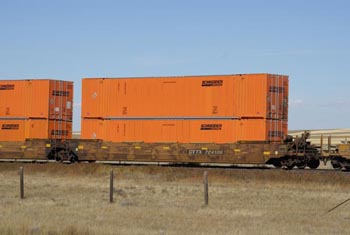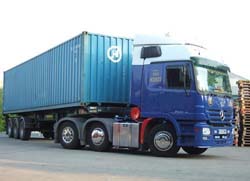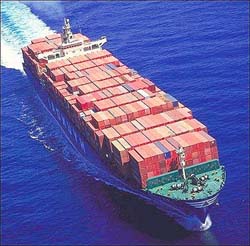|
Shippable Energy Container
Let’s imagine a large cargo container, which would store electrical energy, and
could be transported from a source of energy to anywhere it might be needed.
The containers could be shipped by truck, rail or boat and would provide electrical
energy, much like a gigantic battery.
The concept of shippable energy
containers might be more economical than long electrical transmission lines.
The containers would “fill up” at some large energy farm and then be shipped to
“filling stations” throughout the country. |
 |
| I’m going to assume that
each container would store about 100,000 kilowatt-hours of energy. A special
portion of the container would be reserved to power the electric truck, needed to
transport the container. At $0.1 per kilowatt-hour, the filled container would
haul about $10,000 worth of energy. |
| Empty containers would be
shipped back to the energy source, where they would be filled up again. The
transportation “energy reserve” within the container would be used to power the
truck hauling the device. Perhaps, the reserve would be designed so once half
the total energy in the reserve was used up, energy would then be pulled from the
main storage unit. This would insure that there would always be a 50% hauling
energy margin in each unit. Maybe the reserve would store about 1% of the
total container storage or about 1MW hours. |
|
 |
 |
| For those containers
which are stationary for a month or more, a large solar panel might be mounted on
top of the container, to charge up the energy reserve portion, while the container
was parked. Once the reserve was charged up, any additional energy would flow
into the main container storage. Perhaps as much as 4KW of solar panel power
could be on the container top. Assuming 6 hours of sunlight per day, such a
panel would produce 24KW-hours of energy per day. If the container was
stationary for 30 days, the solar panel would pump 720KW-hours of energy into the
unit. That should be plenty of energy to get the container back to the energy farm. |
| Is 1000KW hours enough
energy for the electric hauling truck? Many hybrid cars claim a 40 mile range
with about 20KW hours of battery storage.1000KW hours would be 50 times more
massive. If we assume a speed of 30 miles per hour and a hauling range of 120
miles, then the truck might have a running time of 4 hours drawing 250KW of power.
That seems like enough. |
| Future energy farms might
be very large and remote. Transporting the energy in containers might end up
being more economic than long electrical transmission lines. Shipping the
containers in and out of the energy farm by rail should be quite efficient.
Once the energy train reached towns, individual energy trucks would then move them
to where they were needed. Large energy boats might also be used to haul a
large number of containers from off-shore energy farms. A single boat might
haul 500 containers. |
| I imagine these energy cargo
containers to supply energy to whole communities. Assume each community
household needs 25KW-hours of energy per day. A container holding 100MW hours would
then provide a community of 100 homes, enough energy for 30 days. This seems
like a reasonable period. What kind of energy
density would be needed for these energy containers? Assume a container 40
feet long, 9.5 feet high and 8 feet wide. The total outside volume would be
3040 cubic feet. For 100,000KW-hours, the energy density would have to be 33
KW-hours per cubic foot or 1.1KW-hours per liter or 4200K joules per liter or 4.2MJ
per liter.
In comparison, a lithium ion battery stores about
1MJ per liter. Gasoline is about 34MJ per liter. Coal is about 20MJ per liter.
So, the energy container would need to store more than a battery but much less than
conventional fuels. I think in time, super capacitor technology will be able
to achieve this kind of energy storage density. |
 |
 |
If each cargo container stored
100MW-hours of energy, the ship would be able to fill 6 containers per day or
about 8.3 containers per 500 mile run. It might take two full days to
complete a 1000 mile loop. Of course, longer runs might be possible if
the wind conditions were ideal. Perhaps the ship would only be able to
average three containers per day. A voyage lasting 100 days would fill
300 containers. At about $10,000 worth of energy per container, the ship
would be able to collect 3 million dollars worth of energy per voyage or
roughly 10 million dollars per year. If we assume a 5 year payback period,
the expense to equip a ship for this energy production would have to cost less
than $50M. |
|
| |
|